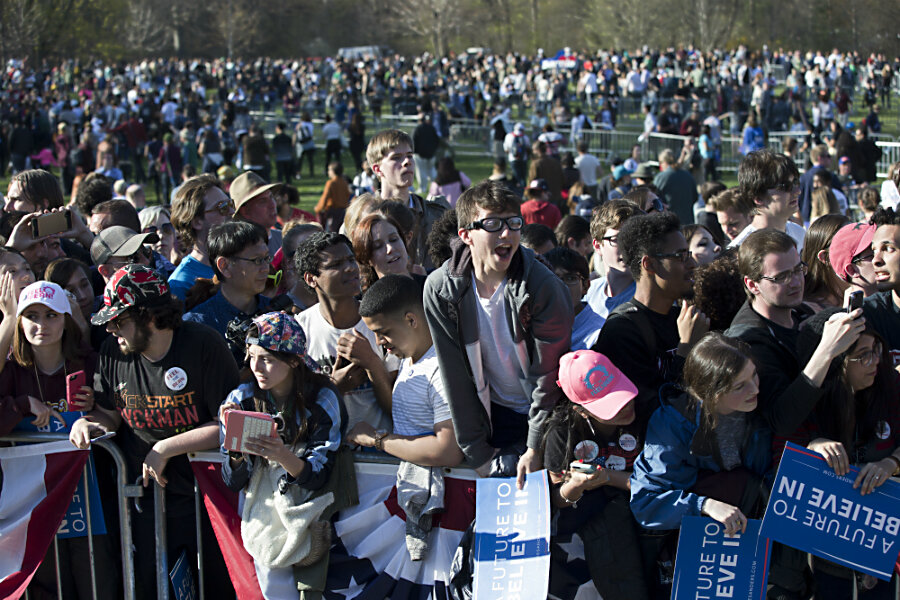Brooklyn crowd was humongous. Does that show Sanders momentum?
Loading...
| Washington
Bernie Sanders draws big crowds. He’s proven that throughout his campaign for the Democratic presidential nomination. And Sunday he drew his biggest crowd yet, according to aides: 28,000 people at a rally in Brooklyn’s Prospect Park.
“This is a campaign that is on the move. With your help on Tuesday we’re going to win right here in New York,” said Vermont's Senator Sanders to the throng gathered to hear him on a warm spring day.
Does the sheer size of this audience – which packed the park – show that Sanders’s assertion is right? When it comes to rallies, do numbers and enthusiasm indicate a candidate on the move?
Lots of campaign advance workers and many reporters would say “yes.” It takes energy to get off the couch and go to a political event, after all. That shows dedication. It indicates support. Plus, big crowds draw media coverage and build buzz, which in turn helps build bigger crowds at the next event, which draws even more media coverage, creating a foot-powered political feedback loop.
You know who else draws big crowds? Donald Trump. He’s the antithesis of Sanders in many ways, and he’s not great at delegate allocation rules, but he remains the GOP front-runner by a fair margin. Case closed.
But lots of other reporters and most political scientists would say “no.” We’d side with them. A crowd is a crowd. It’s not a prognostication of future success. If it were, the baseball team with the biggest attendance would always win the World Series. Last year’s champ would have been the Los Angeles Dodgers, not the Kansas City Royals.
Why are crowds not a political harbinger? The first reason is exaggeration. Campaign staffers have lots of incentive to puff their numbers. And they do.
This doesn’t seem to be the case with Sanders – his event at Prospect Park on Sunday was indeed packed. But another reason why crowd size isn’t a great indicator is that rallies often get bigger and more intense as a matter of course when campaigns near a turning point. Take the 2012 general election campaign: Mitt Romney’s crowds grew in size and enthusiasm as November loomed. Lots of news accounts mentioned it. He then lost the popular vote by 5 million people.
The final reason size doesn’t matter here, and the one that seems most applicable to the Sanders example, is that rallies reflect the size and demographics of their locations. Sanders has drawn huge crowds in college towns, for instance, where lot of his core supporters – young, liberal – live. Sunday’s event was in Brooklyn, the place where many of those young white college-educated lefties yearn to move to after they graduate. It’s Sanders Ground Zero. There are lots of stores selling hand-made cheese and designer axes. Of course they’re going to flock to hear him speak.
Also, Sanders was raised in Brooklyn. Did we mention that?
Political crowd numbers are mostly irrelevant, the gang at the University of Virginia’s Crystal Ball political newsletter wrote late last year. Mr. Romney’s not the only losing candidate to get false hope from his audiences. In 1972, Democratic nominee Sen. George McGovern drew big crowds too. He got crushed.
But the Sanders numbers may indicate something about the Democratic Party yet to come, according to Crystal Ball’s Larry Sabato, Kyle Kondik, and Geoffrey Skelley.
“At the end of the day, the crowd sizes don’t indicate that Sanders will win – far from it – but the one takeaway from them is that the left wing of the Democratic Party wants to entertain the idea of a Clinton-less future, and Sanders is the candidate who has received the left’s energy at this point,” the trio wrote last year.
At the end of the day, that means the crowds may not be as much about Sanders himself as they appear to be.
That doesn’t mean he hasn’t been an effective candidate or maximized his available support. Few thought he’d be as serious a competitor to Hillary Clinton as he’s been. It means, as Jamelle Bouie asserts Monday in Slate, that Sanders hasn’t really sparked a new movement on the left.
Sanders has not built a new coalition of left-leaning voters and/or drawn in groups who weren’t liberal prior to his emergence on the national dais, according to Mr. Bouie. He’s simply been a successful focus for preexisting discontent.
“Sanders has simply reconstituted the usual liberal coalition that backs insurgents in a Democratic primary. He has done so with incredible success. But a movement? There never was a Bernie Sanders movement,” he writes.






